Forecast of the Demand for Electric Mobility for Rome–Fiumicino International Airport
Abstract
:1. Introduction
- The forecast of EV turnout at airport parking facilities at time horizon 2025–2030, for clusters of vehicles (chauffeurs, private cars, rental cars, and taxis).
- The estimation of charging points potentially required accommodating the forecasted EV turnout.
2. The Case Study
- Parking areas for passengers and operators.
- Sub-concession parking areas for car rentals, chauffeurs, and buses.
- Non-sub-concession parking areas for taxis, chauffeurs, buses, and shuttles.
- Public collective railway transport with the city of Rome: Ferrovia Laziale FL1 local train, Leonardo Express nonstop service.
- Public collective railway transport to major Italian cities: Trenitalia Frecciargento high-speed trains.
- Public and private collective road transport: shuttle buses by private companies.
- Public personal road transport: taxis.
- Private personal road transport: chauffeurs and car rentals.
3. Analysis of EV Development Scenarios at Different Levels
3.1. Global Level
- Boston Consulting Group [48], where the analysis led to a single scenario, presented here as BCG.
- Bloomberg NEF [49], under the assumption that in 2025, combustion engine cars and EVs will reach economic parity, presented here as BNEF.
- IEA [50], which proposes two scenarios: IEA new policy scenario (NPS), this is the most conservative scenario and includes the impact of announced policy ambitions, and a more ambitious one, IEA 30@30, which accounts for the pledges of the EVs EV30@30 campaign to reach 30% market share for electric vehicles by 2030.
3.2. European Level
- Boston Consulting Group [48] (BCG).
- Cambridge Econometrics [51], which develops a set of three scenarios, each assuming a different decarbonization pathway taken by most major car manufacturers to meet EU CO2 emissions reduction targets. The scenarios are presented as: CAM, CAM (Tech PHEV), and CAM (Tech OEM).
- Transport and Environment [52], which defines five scenarios, based on the incremental fuel efficiency upgrade of future ICE car fleet. The scenarios are presented as: TRA&ENV (b), TRA&ENV (lICE), TRA&ENV (hICE), TRA&ENV (BEV), and TRA&ENV (PHEV).
- IEA [50], which proposes only an NPS scenario to forecast new electric vehicles sales in Europe.
3.3. Italian Level
3.4. Definition of Reference Forecasting Scenarios for the Case Study
- Conservative scenario: significant incentive policies are not considered, and it is in line with the basic one of the Politecnico di Milano study [53], which envisages the least expansion.
- PNIEC scenario: it is in line with the objectives on electrical mobility included in the Italian Integrated National Plan for Energy and Climate (Piano Nazionale Integrato per l’Energia e il Clima 2030, PNIEC) [54] (to have 6,000,000 EVs circulating in 2030); consequently, it is the upper limit for the demand for Italian electric mobility in 2030.
- The number of cars sold in 2019, for every typology, is obtained from the historical analysis.
- The number of cars sold in the horizon year 2030 is such to make the fleet in circulation reach the corresponding value for the scenario considered.
4. Forecasting of Rome–Fiumicino Airport EV Development Scenarios
4.1. Data and Methodology
- Characterization of parking areas (via satellite imaging of public domain).
- Identification of internal collective transport lines (shuttles).
- Identification of public transport line.
- Data on stops in 2019 (duration, number of vehicles, and registration plates).
- Hourly detection of private traffic flows.
- Analysis of the consistency of parking areas (via identification of areas from satellite imaging and allocation to cluster of users) to allocate charging points.
- Analysis of the duration of stops (from data provided by ADR) to allocate type of charging points (slow/fast charging).
- Analysis of vehicle age distribution (from license plate data provided by ADR) to estimate the renewal rate by cluster and the consequent EV penetration.
- Estimation of EV access number by cluster; obtained by combining the age distribution profiles with the sales forecasts derived from the analysis of the scenarios.
- A block diagram summarizing the main steps of the methodology is shown in Figure 10.
- An expected life of 5 years for taxi cars.
- An expected life of 2.5 years for a rental car.
- The same age profile for airport operators’ vehicles as those of passengers.
- Saturation of the logistic curve 5 years forward for taxis and chauffeurs compared to private cars.
4.2. Results
- Vehicles accessing airport car parks (particularly the multistory car park) are often company cars, which are usually replaced more frequently than private cars.
- Old cars travel fewer kilometers per year, while users travelling more are forced to replace cars frequently due to wear, thus newer cars are likely to be a significant part of airport car park use.
5. Preliminary Sizing of Charging Infrastructure
6. Conclusions
- The estimated share of EVs accessing Fiumicino airport parks in 2025 is between 3% and 7%.
- The estimated share of EVs accessing Fiumicino airport car parks in 2030 is between 10% and 35%.
- The charging points potentially necessary to serve the share of EVs (private cars, taxis, NCC) affluent to the Fiumicino airport parks are 550–1100 in 2025 and 2300–7000 in 2030.
- The total power of recharging points relating to shuttles, buses, and TPL is estimated to be equal to 4.5 MW.
- The total power for airside vehicle recharging is estimated to be equal to 20 MW with contemporaneity assumed at 50%.
Author Contributions
Funding
Institutional Review Board Statement
Informed Consent Statement
Conflicts of Interest
References
- Uherek, E.; Halenka, T.; Borken-Kleefeld, J.; Balkanski, Y.; Berntsen, T.; Borrego, C.; Gauss, M.; Hoor, P.; Juda-Rezler, K.; Lelieveld, J.; et al. Transport impacts on atmosphere and climate: Land transport. Atmos. Environ. 2010, 44, 4772–4816. [Google Scholar] [CrossRef]
- González Palencia, J.C.; Nguyen, V.T.; Araki, M.; Shiga, S. The Role of Powertrain Electrification in Achieving Deep Decarbonization in Road Freight Transport. Energies 2020, 13, 2459. [Google Scholar] [CrossRef]
- González Palencia, J.C.; Araki, M.; Shiga, S. Energy consumption and CO2 emissions reduction potential of electric-drive vehicle diffusion in a road freight vehicle fleet. Energy Procedia 2017, 142, 2936–2941. [Google Scholar] [CrossRef]
- Ortmeyer, T.H.; Pillay, P. Trends in transportation sector technology energy use and greenhouse gas emissions. Proc. IEEE 2001, 89, 1837–1847. [Google Scholar] [CrossRef]
- Harvey, L. Global climate-oriented transportation scenarios. Energy Policy 2013, 54, 87–103. [Google Scholar] [CrossRef]
- Yuan, X.; Li, X. Mapping the technology diffusion of battery electric vehicle based on patent analysis: A perspective of global innovation systems. Energy 2021, 222, 119897. [Google Scholar] [CrossRef]
- Jorgensen, K. Technologies for electric, hybrid and hydrogen vehicles: Electricity from renewable energy sources in transport. Util. Policy 2008, 16, 72–79. [Google Scholar] [CrossRef]
- Sanguesa, J.A.; Torres-Sanz, V.; Garrido, P.; Martinez, F.J.; Marquez-Barja, J.M. A Review on Electric Vehicles: Technologies and Challenges. Smart Cities 2021, 4, 372–404. [Google Scholar] [CrossRef]
- Herrmann, F.; Rothfuss, F. 1—Introduction to hybrid electric vehicles, battery electric vehicles, and off-road electric vehicles. In Advances in Battery Technologies for Electric Vehicles; Scrosati, B., Garche, J., Tillmetz, W., Eds.; Woodhead Publishing: Sawston, UK, 2015; pp. 3–16. [Google Scholar] [CrossRef]
- Dulău, L.I.; Bică, D. Effects of Electric Vehicles on Power Networks. Procedia Manuf. 2020, 46, 370–377. [Google Scholar] [CrossRef]
- Richard; Yurnaidi, Z. Potential Impacts of EV on Developing Countries’ Electricity Systems. Available online: https://accept.aseanenergy.org/potential-impacts-of-ev-on-developing-countries-electricity-systems-and-how-to-mitigate-them/ (accessed on 17 August 2021).
- Sitohang, J.; Zulfikar, Y. A New Beginning for Electric Vehicle, and How Southeast Asia Could Jump in and Ride the Wave of Electric Vehicle. Available online: https://accept.aseanenergy.org/a-new-beginning-for-electric-vehicle/ (accessed on 17 August 2021).
- Chen, Y.; Dou, A.; Zhang, Y. A Review of Recycling Status of Decommissioned Lithium Batteries. Front. Mater. 2021, 8, 12. [Google Scholar] [CrossRef]
- Plötz, P.; Gnann, T.; Wietschel, M. Modelling market diffusion of electric vehicles with real world driving data—Part I: Model structure and validation. Ecol. Econ. 2014, 107, 411–421. [Google Scholar] [CrossRef] [Green Version]
- IEA. Global EV Outlook 2021; IEA, 2021; Available online: https://www.iea.org/reports/global-ev-outlook-2020 (accessed on 17 August 2021).
- Wesseling, J.H.; Faber, J.; Hekkert, M.P. How competitive forces sustain electric vehicle development. Technol. Forecast. Soc. Chang. 2014, 81, 154–164. [Google Scholar] [CrossRef] [Green Version]
- Gnann, T.; Stephens, T.S.; Lin, Z.; Plötz, P.; Liu, C.; Brokate, J. What drives the market for plug-in electric vehicles?—A review of international PEV market diffusion models. Renew. Sustain. Energy Rev. 2018, 93, 158–164. [Google Scholar] [CrossRef]
- Osieczko, K.; Zimon, D.; Płaczek, E.; Prokopiuk, I. Factors that influence the expansion of electric delivery vehicles and trucks in EU countries. J. Environ. Manag. 2021, 296, 113177. [Google Scholar] [CrossRef]
- Gelmanova, Z.S.; Zhabalova, G.G.; Sivyakova, G.A.; Lelikova, O.N.; Onishchenko, O.N.; Smailova, A.A.; Kamarova, S.N. Electric cars. Advantages and disadvantages. J. Phys. Conf. Ser. 2018, 1015, 052029. [Google Scholar] [CrossRef] [Green Version]
- Kong, D.; Xia, Q.; Xue, Y.; Zhao, X. Effects of multi policies on electric vehicle diffusion under subsidy policy abolishment in China: A multi-actor perspective. Appl. Energy 2020, 266, 114887. [Google Scholar] [CrossRef]
- Trencher, G. Strategies to accelerate the production and diffusion of fuel cell electric vehicles: Experiences from California. Energy Rep. 2020, 6, 2503–2519. [Google Scholar] [CrossRef]
- Villa, D.; Montoya, A. A taxonomy of energy consumption models for electric vehicles. In Proceedings of the MOVICI-MOYCOT 2018: Joint Conference for Urban Mobility in the Smart City, Medellin, Colombia, 18–20 April 2018; pp. 1–7. [Google Scholar]
- Franzò, S.; Nasca, A. The environmental impact of electric vehicles: A novel life cycle-based evaluation framework and its applications to multi-country scenarios. J. Clean. Prod. 2021, 315, 128005. [Google Scholar] [CrossRef]
- Fan, V.H.; Meng, K.; Dong, Z. Integration of Electric Vehicle Load and Charging Infrastructure in Distribution Network. In Proceedings of the 2021 IEEE Transportation Electrification Conference & Expo (ITEC), Chicago, IL, USA, 21–25 June 2021; pp. 1–6. [Google Scholar]
- Manganelli, M.; Undre, V.; Soldati, A. Optimal Control of Domestic Storage via MPC: The Impact of the Prediction of User Habits, including Power Market and Battery Degradation. In Proceedings of the 2020 2nd IEEE International Conference on Industrial Electronics for Sustainable Energy Systems (IESES), Cagliari, Italy, 1–3 September 2020; pp. 67–72. [Google Scholar]
- Mwasilu, F.; Justo, J.J.; Kim, E.-K.; Do, T.D.; Jung, J.-W. Electric vehicles and smart grid interaction: A review on vehicle to grid and renewable energy sources integration. Renew. Sustain. Energy Rev. 2014, 34, 501–516. [Google Scholar] [CrossRef]
- Cochi, S.; Falvo, M.C.; Manganelli, M.; Caneponi, G.; Cazzato, F.; Clerico, M.D. Active distribution grids and EV charging stations: A centralized approach for their integration. In Proceedings of the 2018 7th International Conference on Renewable Energy Research and Applications (ICRERA), Paris, France, 14–17 October 2018; pp. 1466–1471. [Google Scholar]
- Richardson, D.B. Electric vehicles and the electric grid: A review of modeling approaches, Impacts, and renewable energy integration. Renew. Sustain. Energy Rev. 2013, 19, 247–254. [Google Scholar] [CrossRef]
- Liu, X.; Bie, Z. Optimal Allocation Planning for Public EV Charging Station Considering AC and DC Integrated Chargers. Energy Procedia 2019, 159, 382–387. [Google Scholar] [CrossRef]
- Liu, J.-P.; Zhang, T.-X.; Zhu, J.; Ma, T.-N. Allocation optimization of electric vehicle charging station (EVCS) considering with charging satisfaction and distributed renewables integration. Energy 2018, 164, 560–574. [Google Scholar] [CrossRef]
- Pal, A.; Bhattacharya, A.; Chakraborty, A.K. Allocation of electric vehicle charging station considering uncertainties. Sustain. Energy Grids Netw. 2021, 25, 100422. [Google Scholar] [CrossRef]
- Ajanovic, A.; Siebenhofer, M.; Haas, R. Electric Mobility in Cities: The Case of Vienna. Energies 2021, 14, 217. [Google Scholar] [CrossRef]
- Ruggieri, R.; Ruggeri, M.; Vinci, G.; Poponi, S. Electric Mobility in a Smart City: European Overview. Energies 2021, 14, 315. [Google Scholar] [CrossRef]
- Triebke, H.; Siehler, E.; Staebler, E. Forecast Model for Electromobile Loads at Stuttgart Airport and Fair. Available online: http://publica.fraunhofer.de/eprints/urn_nbn_de_0011-n-4802121.pdf (accessed on 17 August 2021).
- Xiang, Y.; Cai, H.; Liu, J.; Zhang, X. Techno-economic design of energy systems for airport electrification: A hydrogen-solar-storage integrated microgrid solution. Appl. Energy 2021, 283, 116374. [Google Scholar] [CrossRef]
- Silvester, S.; Beella, S.K.; van Timmeren, A.; Bauer, P.; Quist, J.; van Dijk, S. Exploring design scenarios for large-scale implementation of electric vehicles; the Amsterdam Airport Schiphol case. J. Clean. Prod. 2013, 48, 211–219. [Google Scholar] [CrossRef]
- Cardona, E.; Sannino, P.; Piacentino, A.; Cardona, F. Energy saving in airports by trigeneration. Part II: Short and long term planning for the Malpensa 2000 CHCP plant. Appl. Therm. Eng. 2006, 26, 1437–1447. [Google Scholar] [CrossRef]
- Cardona, E.; Piacentino, A.; Cardona, F. Energy saving in airports by trigeneration. Part I: Assessing economic and technical potential. Appl. Therm. Eng. 2006, 26, 1427–1436. [Google Scholar] [CrossRef]
- Zhang, Y.; Si, P.; Feng, Y.; Rong, X.; Wang, X.; Zhang, Y. Operation strategy optimization of BCHP system with thermal energy storage: A case study for airport terminal in Qingdao, China. Energy Build. 2017, 154, 465–478. [Google Scholar] [CrossRef]
- Vosper, P. Airports to be the Next Wave of EV Charging Stations. Available online: https://www.green-technology.org/wp-content/uploads/2020/11/Juicebar-ReprintParkingTodayOctober2020-1.pdf (accessed on 17 August 2021).
- Stuttgart Airport. EV Charging Stations. Available online: https://www.stuttgart-airport.com/getting-here/ev-charging-stations/ (accessed on 17 August 2021).
- Airport, L.L. Electric Vehicle Charging Points at London Luton Aiport. Available online: https://www.london-luton.co.uk/parking/electric-vehicle-charging (accessed on 17 August 2021).
- Toronto Pearson. Electric Vehicle Charging Stations. Available online: https://www.torontopearson.com/en/transportation-and-parking/ev-charging-stations (accessed on 17 August 2021).
- Nigro, M.; Ferrara, M.; De Vincentis, R.; Liberto, C.; Valenti, G. Data Driven Approaches for Sustainable Development of E-Mobility in Urban Areas. Energies 2021, 14, 3949. [Google Scholar] [CrossRef]
- Wikipedia—List of the Busiest Airports in Europe. Available online: https://en.wikipedia.org/wiki/List_of_the_busiest_airports_in_Europe (accessed on 4 January 2021).
- Assaeroporti. Statistiche Dati di Traffico Aeroportuale Italiano. Available online: https://assaeroporti.com/statistiche/ (accessed on 4 January 2021).
- Italian Civil Aviation Authority. Rome-Fiumicino Master Plan; ENAC: Toulouse France, 2016. [Google Scholar]
- Mosquet, X.; Dinger, A.; Xu, G.; Andersen, M.; Tominaga, K.; Zablit, H. The Electric Car Tipping Point; Boston Consulting Group: Boston, MA, USA, 2018. [Google Scholar]
- BloombergNef. BNEF EVO Report 2020; BloombergNEF: London, UK, 2021. [Google Scholar]
- IEA. Global EV Outlook 2019; IEA, 2019; Available online: https://www.iea.org/reports/global-ev-outlook-2019 (accessed on 17 August 2021).
- Cambridge Econometrics. Low-Carbon Cars in Europe: A Socio-Economic Assessment; Cambridge Econometrics: Cambridge, UK, 2018. [Google Scholar]
- Bannon, E. Electric Surge: Carmakers’ Electric Car Plans across Europe 2019–2025; Transport & Environment: Brussels, Belgium, 2019. [Google Scholar]
- Politecnico di Milano. E-MOBILITY REPORT 2018—Le Opportunità e le Sfide per lo Sviluppo della Mobilità Elettrica in Italia; Politecnico di Milano: Milan, Italy, 2018. [Google Scholar]
- Italian Ministry of Economic Development; Italian Ministry of the Environment and Protection of Natural Resources and the Sea; Italian Ministry of Infrastructure and Transport. Piano Nazionale Integrato per l’Energia e il Clima 2030; Ministero dello Sviluppo Economico: Rome, Italy, 2019.
- AdR Mobility. Available online: https://www.adr.it/adr-mobility (accessed on 1 March 2020).



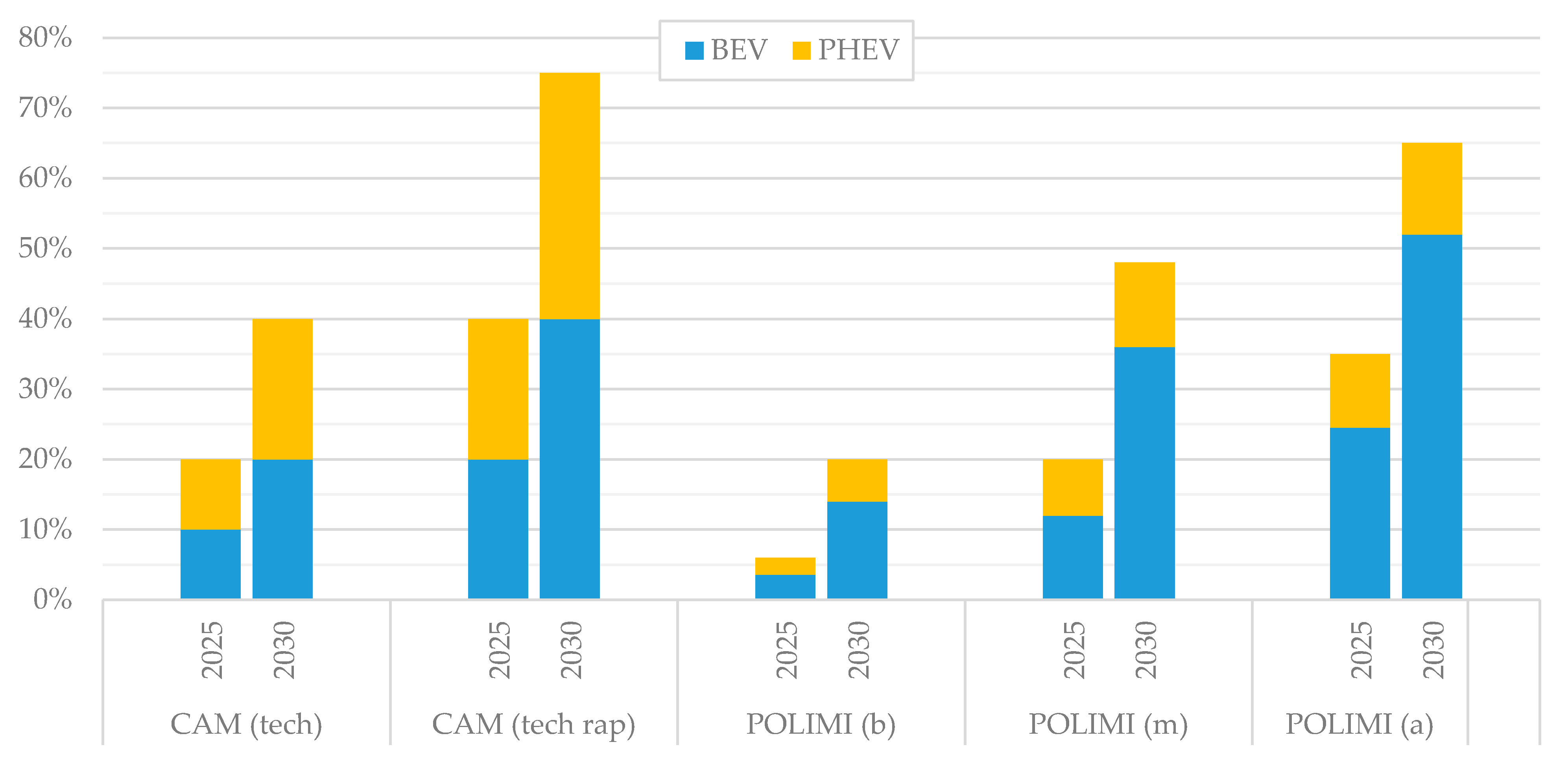
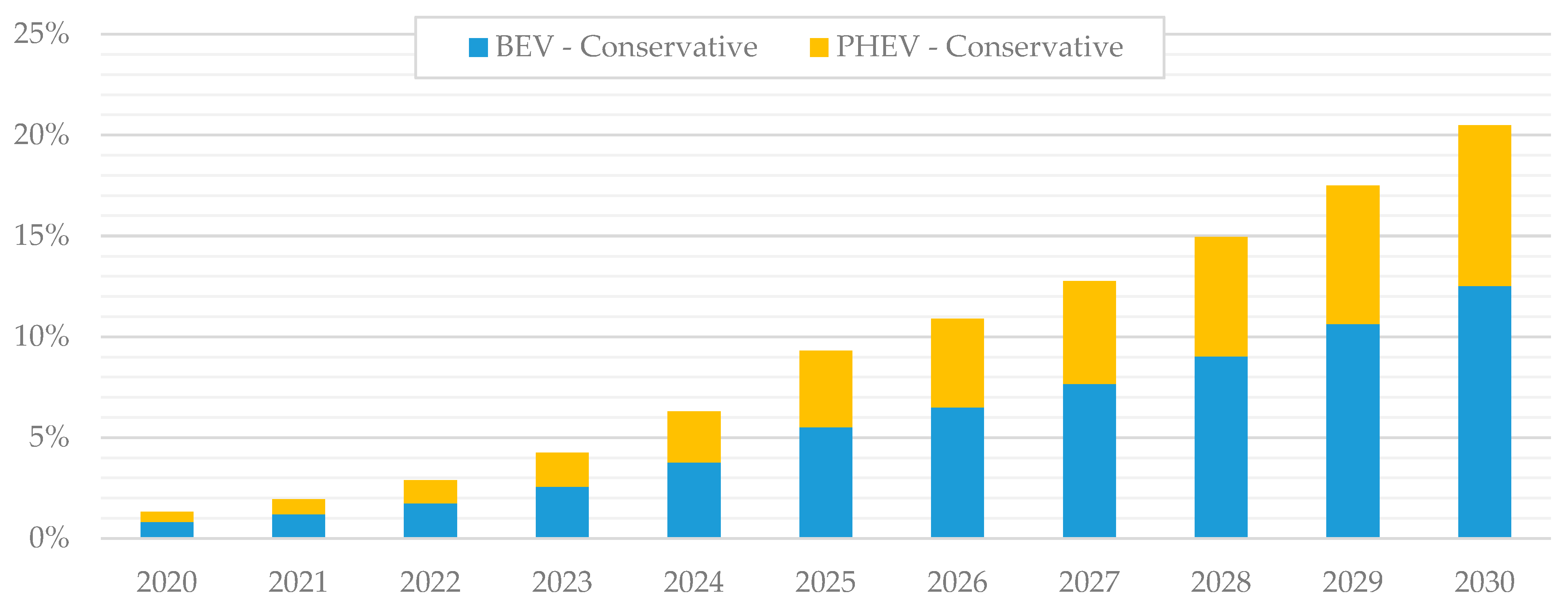

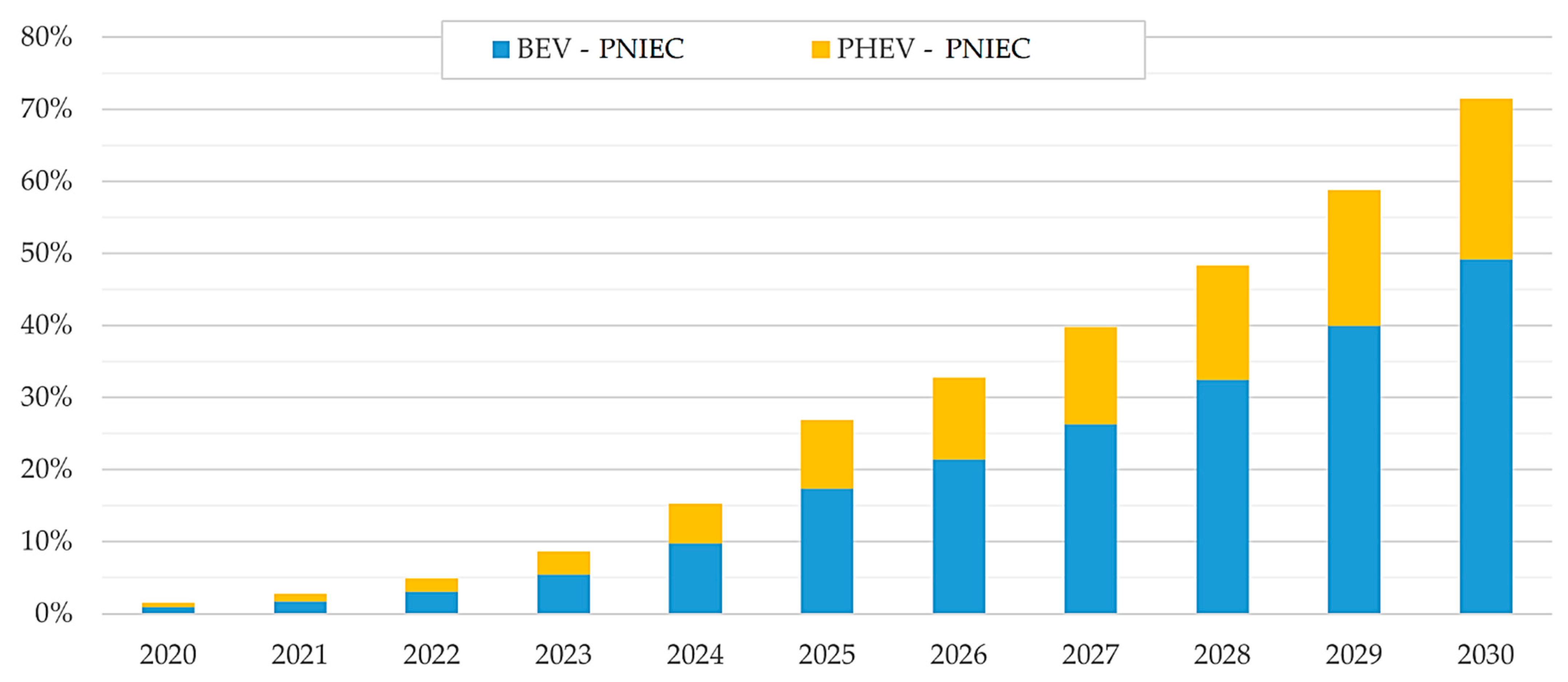
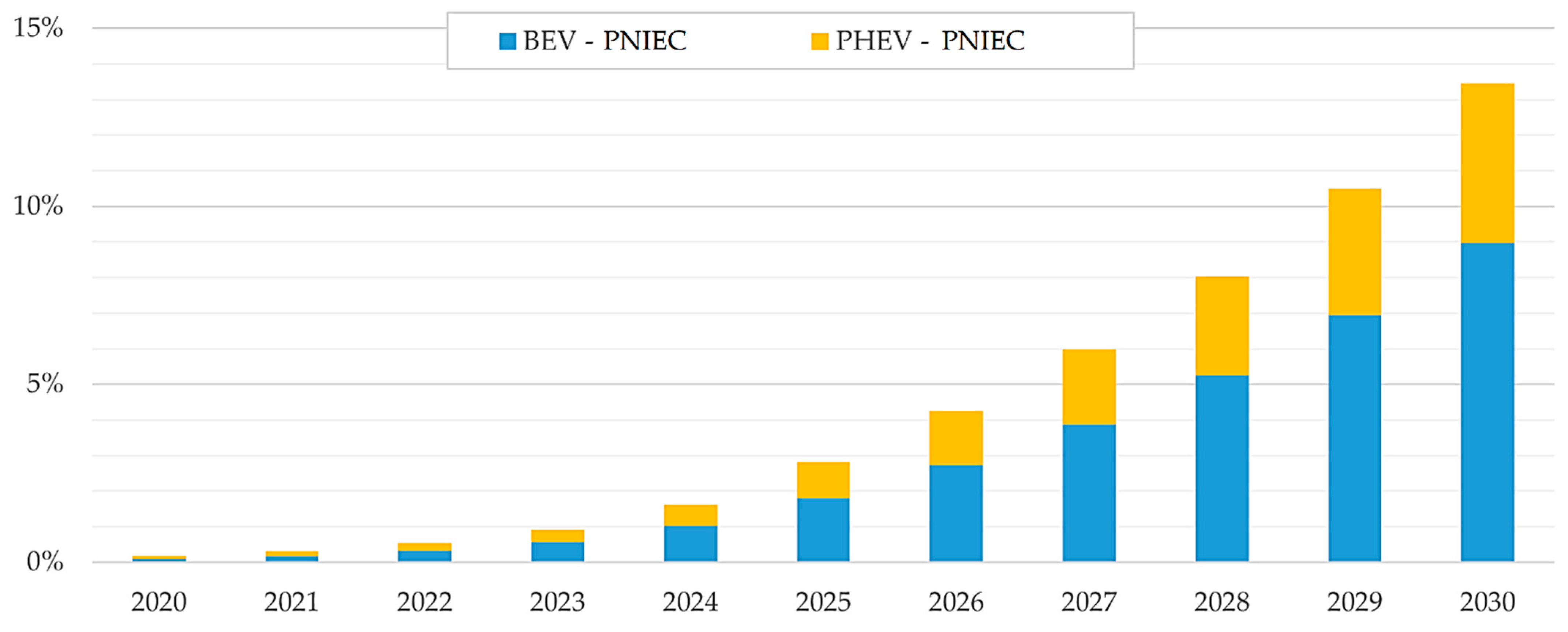
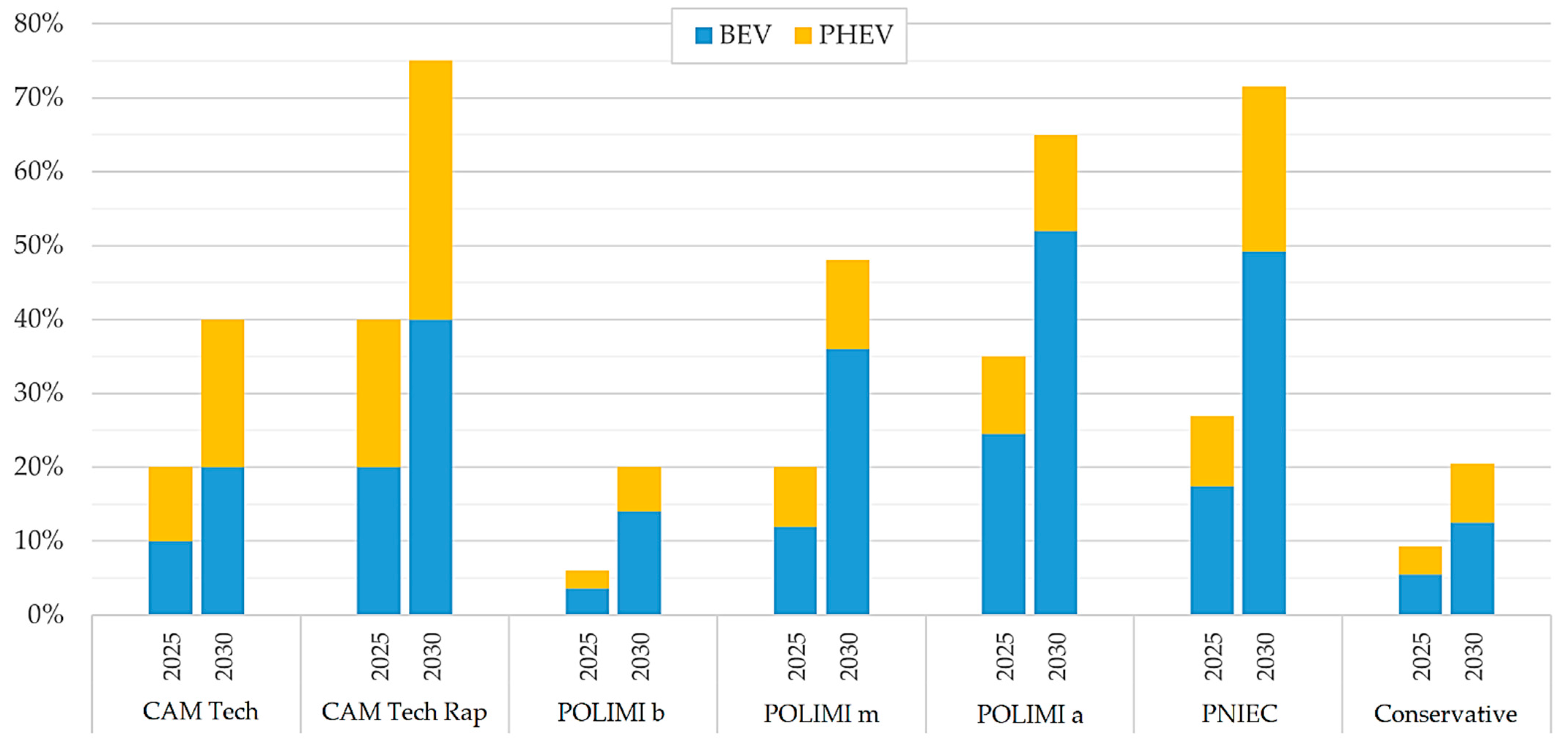

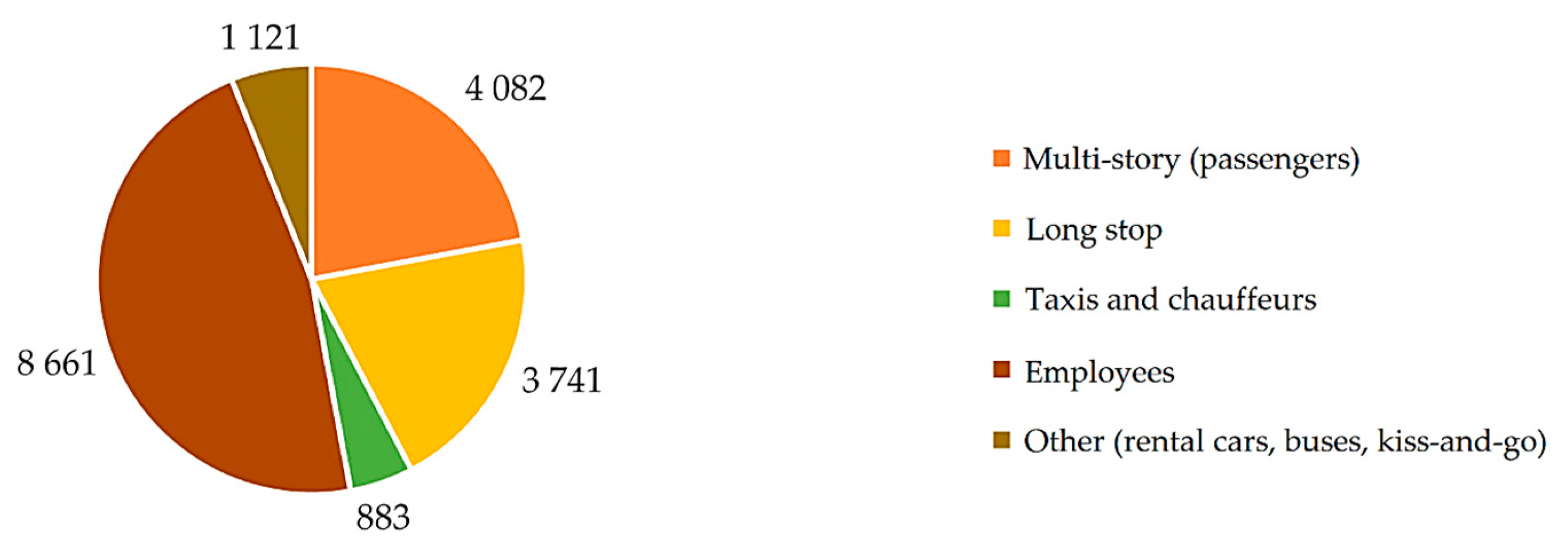
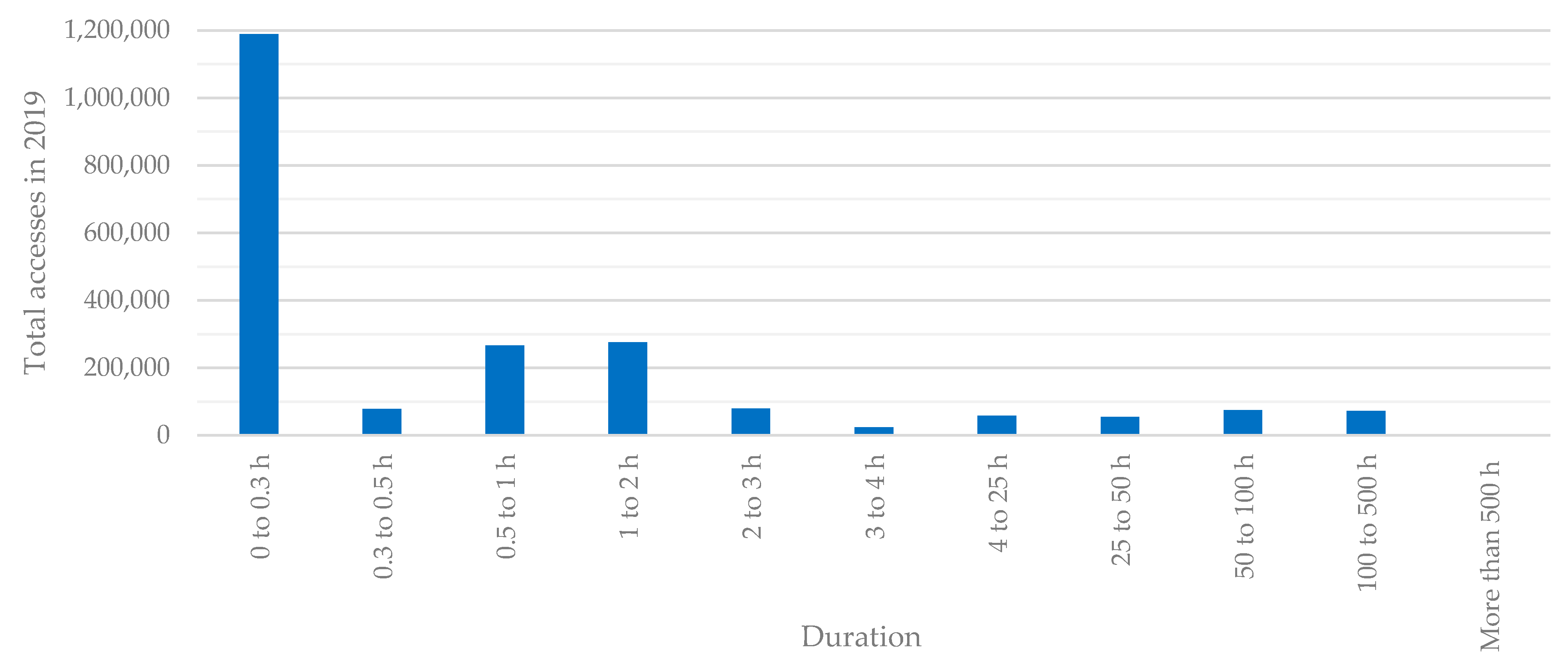
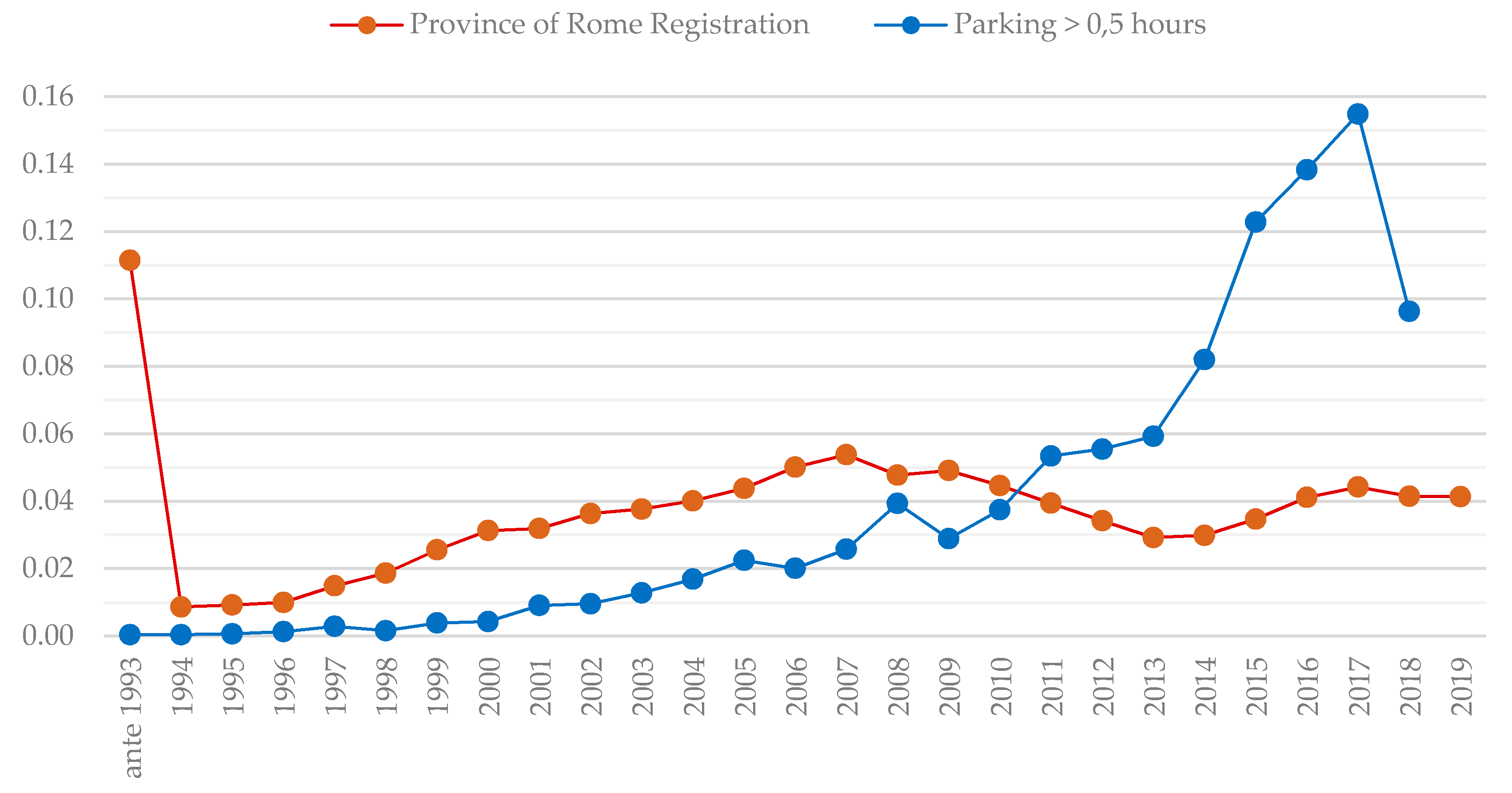
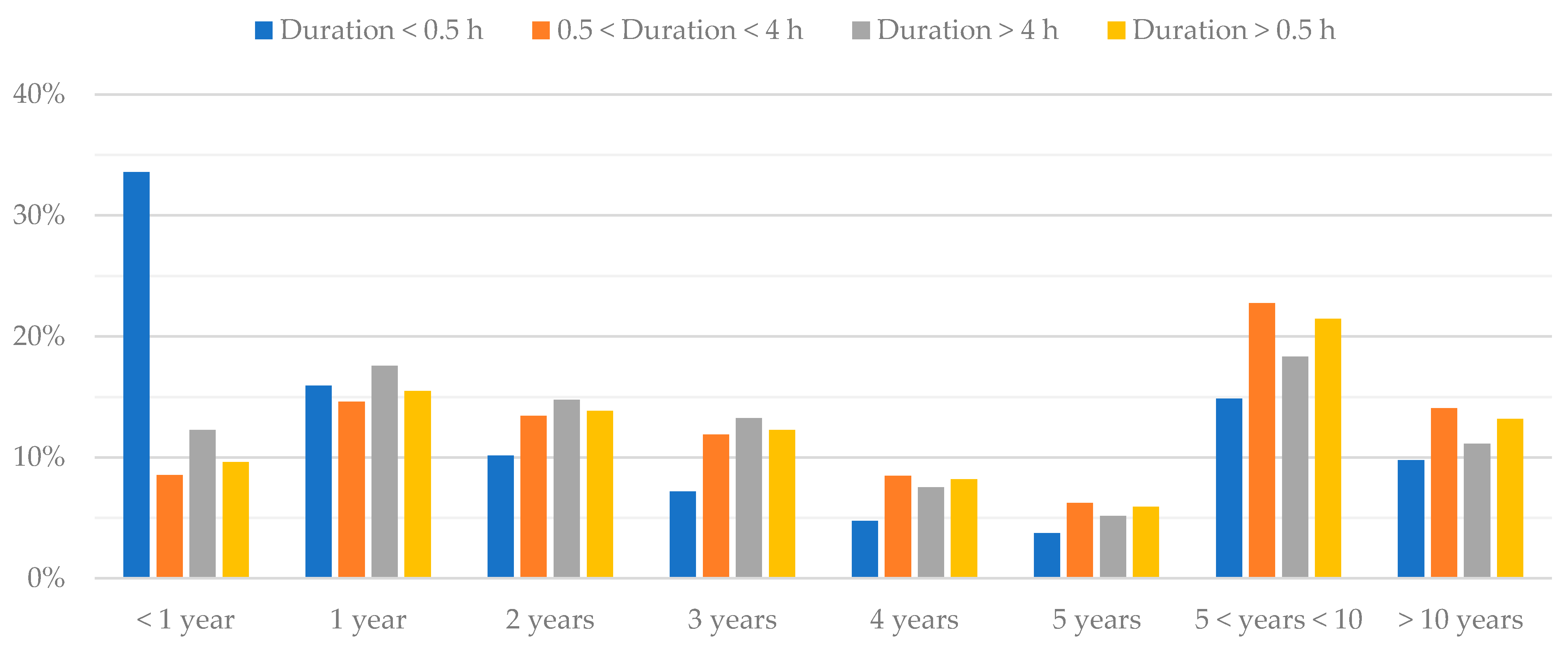

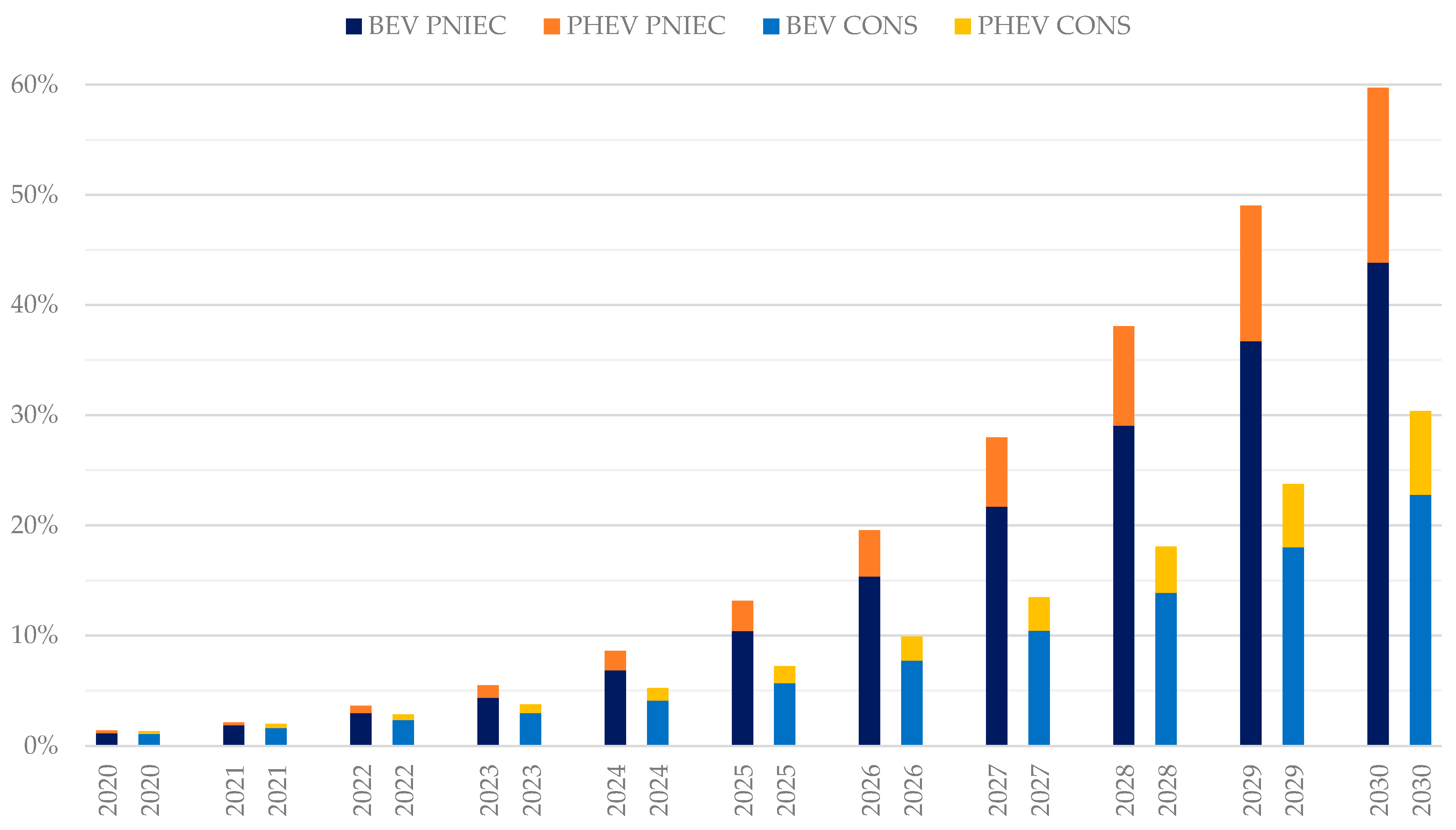
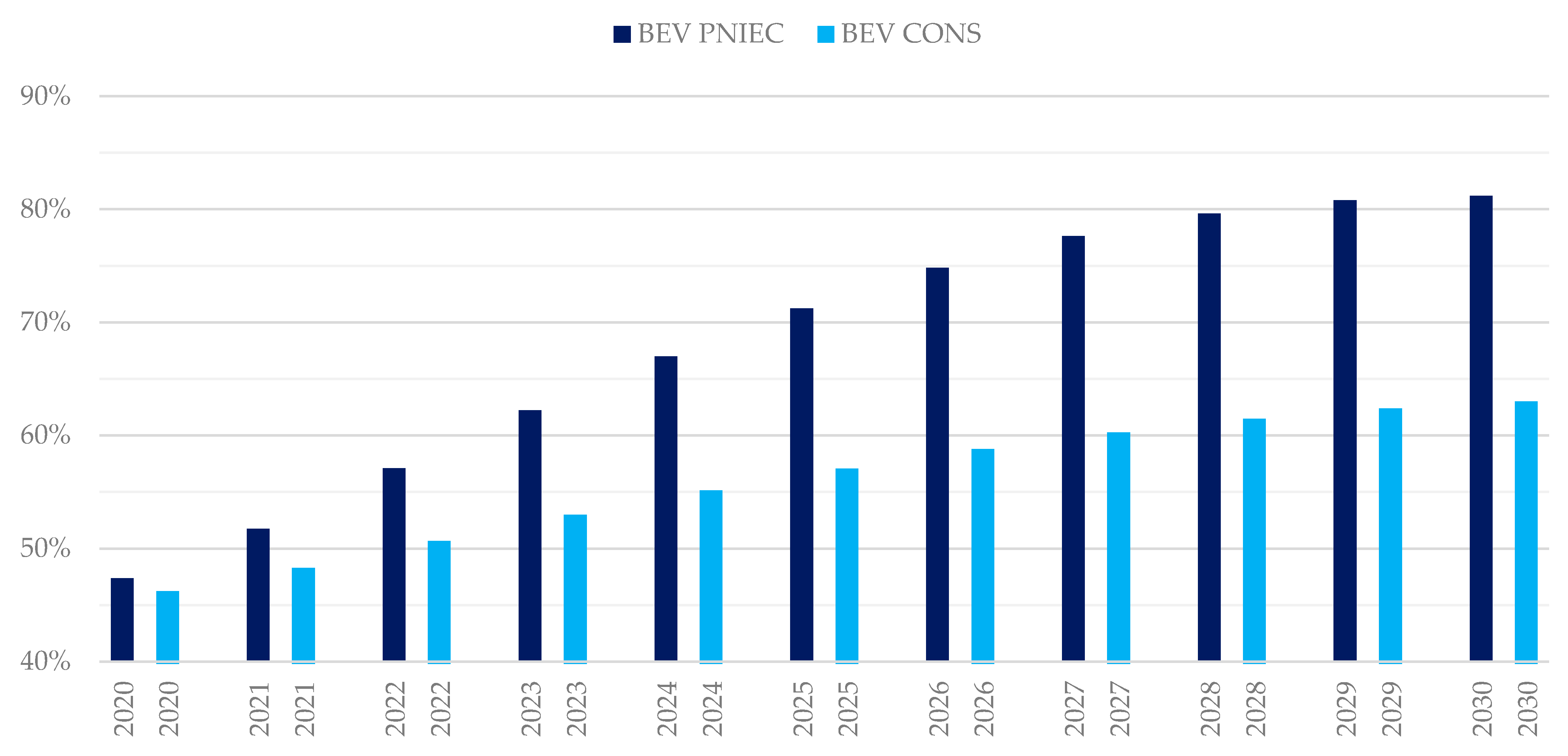
| Field of Action | HEV | PHEV | BEV + REx | BEV | FCEV |
|---|---|---|---|---|---|
| Traction | Thermal and electric | Thermal and electric | Electric | Electric | Electric (battery/fuel cell) |
| Energy storage | Battery and fuel tank | Battery and fuel tank | Battery and small fuel tank | Battery | Battery and hydrogen tank |
| Battery charging | By heat engine (no plug) | From grid via plug | By small heat engine (for charging only) | From grid via plug | By fuel cell |
| Field of Action | Advantage | Disadvantage |
|---|---|---|
| Powertrain, storage | High efficiency of powertrain (~90% vs. ~30% of combustion engines) | Heavy propulsion system (due to sizable battery, hybrid propulsion) |
| Battery technology | Rechargeability | Limited life cycle, complex cell technology |
| Comfort, driving | Excellent acceleration, power transfer (due to torque characteristic) | Limited range (due to current low energy density) |
| Vehicle concept | New vehicle concepts | High design effort |
| Costs | Decreasing life-cycle costs (due to lower maintenance costs) | High component costs (due to current battery price) |
| Ecology, sustainability | No local emission | Current overall carbon footprint (due to current energy mix) |
| Energy storage, charging | Integration of EVs into smart grids | Current limited infrastructure |
| Parking Duration | Share of Total Parking Spot Usage * |
|---|---|
| <2 h | 2.8% |
| >2 h | 97.2% |
| Scenario | Horizon | Parking Category | Slow Charging Stations | Fast Charging Stations |
|---|---|---|---|---|
| Conservative Scenario | 2025 | Multistorey park | 354 | 14 |
| Long-stay park | 270 | 0 | ||
| 2030 | Multistorey park | 1.494 | 56 | |
| Long-stay park | 1.137 | 0 | ||
| PNIEC Scenario | 2025 | Multistorey park | 645 | 26 |
| Long-stay park | 492 | 0 | ||
| 2030 | Multistorey park | 2.939 | 108 | |
| Long-stay park | 2.235 | 0 |
| Vehicle | Power (kW) | Quantity | Capacity (kWh) | Consumption (MWh) |
|---|---|---|---|---|
| Passenger boarding lift | 10 | 16 | 15 | 28 |
| Drinking water tank truck | 10 | 13 | 15 | 23 |
| Lavatory truck | 10 | 13 | 15 | 23 |
| Shuttle bus | 160 | 119 | 120 | 3998 |
| Lift truck | 10 | 7 | 15 | 12 |
| Catering | 10 | 22 | 15 | 38 |
| Forklift | 10 | 13 | 15 | 23 |
| Loader | 75 | 59 | 96 | 654 |
| Onboard cleaning | 10 | 10 | 15 | 17 |
| Minibus | 25 | 29 | 120 | 974 |
| Conveyor belt | 33 | 106 | 36 | 641 |
| Towable passenger stair | 13 | 186 | 35 | 990 |
| Transporter | 33 | 49 | 36 | 296 |
| Large tractor | 10 | 35 | 36 | 397 |
| Small tractor | 68 | 65 | 204 | 2785 |
| Total | 37,446 | 742 | 51,481 | 10,899 |
Publisher’s Note: MDPI stays neutral with regard to jurisdictional claims in published maps and institutional affiliations. |
© 2021 by the authors. Licensee MDPI, Basel, Switzerland. This article is an open access article distributed under the terms and conditions of the Creative Commons Attribution (CC BY) license (https://creativecommons.org/licenses/by/4.0/).
Share and Cite
Acri, R.A.; Barone, S.; Cambula, P.; Cecchini, V.; Falvo, M.C.; Lepore, J.; Manganelli, M.; Santi, F. Forecast of the Demand for Electric Mobility for Rome–Fiumicino International Airport. Energies 2021, 14, 5251. https://doi.org/10.3390/en14175251
Acri RA, Barone S, Cambula P, Cecchini V, Falvo MC, Lepore J, Manganelli M, Santi F. Forecast of the Demand for Electric Mobility for Rome–Fiumicino International Airport. Energies. 2021; 14(17):5251. https://doi.org/10.3390/en14175251
Chicago/Turabian StyleAcri, Romano Alberto, Silvia Barone, Paolo Cambula, Valter Cecchini, Maria Carmen Falvo, Jacopo Lepore, Matteo Manganelli, and Federico Santi. 2021. "Forecast of the Demand for Electric Mobility for Rome–Fiumicino International Airport" Energies 14, no. 17: 5251. https://doi.org/10.3390/en14175251
APA StyleAcri, R. A., Barone, S., Cambula, P., Cecchini, V., Falvo, M. C., Lepore, J., Manganelli, M., & Santi, F. (2021). Forecast of the Demand for Electric Mobility for Rome–Fiumicino International Airport. Energies, 14(17), 5251. https://doi.org/10.3390/en14175251







